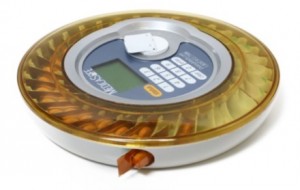 When addiction treatment specialist Zev Schuman-Olivier, MD, found that young adults taking buprenorphine to treat their opioid addiction often stopped using the medication, he began looking for a novel way to address the problem. He is now testing an integrated mobile system that incorporates smartphone videoconferencing and a secure electronic medicine dispenser to allow young adults to take their daily buprenorphine at home, under remote supervision of a recovery coach.
When addiction treatment specialist Zev Schuman-Olivier, MD, found that young adults taking buprenorphine to treat their opioid addiction often stopped using the medication, he began looking for a novel way to address the problem. He is now testing an integrated mobile system that incorporates smartphone videoconferencing and a secure electronic medicine dispenser to allow young adults to take their daily buprenorphine at home, under remote supervision of a recovery coach.
The system, called “MySafeRx,” allows a person taking buprenorphine at home to have a daily videoconference with a mobile recovery coach. After a recovery check-in, the coach uses the MySafeRx Android smartphone app, which has been designed to interface with the Medicasafe pill dispenser, to request a unique access code, which the coach releases through the app to the participant’s smartphone. The participant enters the code into the medicine dispenser, which then releases that day’s buprenorphine dose. By providing daily support each morning at the time of medication-taking, it offers a crucial opportunity to help support recovery.
The recovery coach sends a status update to the patient’s prescriber, to let them know if the patient has taken their daily dose, used any substances, and achieved their recovery daily goals.
Dr. Schuman-Olivier explains that a big advantage of buprenorphine over methadone is that a person does not have to come into a clinic daily to get their medicine. Patients generally receive a prescription for a month’s worth of buprenorphine from their doctor at a time. However, many people being treated for opioid addiction benefit from the structure of checking in with someone every day, he said. Having someone supervise them taking the medication ensures that the patient is taking it, and not diverting it—giving or selling it to someone else.
“I thought, what if we could provide that support and structure at home, ensure they take their medication, and also have the opportunity to have recovery coaching every morning?” said Dr. Schuman-Olivier, Instructor in Psychiatry, Harvard Medical School and Geisel School of Medicine at Dartmouth, Medical Director, Addictions at Cambridge Health Alliance and Investigator, Center for Technology and Behavioral Health at Dartmouth. “The empathy from another person can be very helpful in recovery. But it would be too expensive and time-consuming to have a person drive to the patient’s house every morning.” MySafeRx is a more cost-effective and time-saving solution, he added.
In a study published in 2014, Dr. Schuman-Olivier found that compared to older adults, young adults ages 18-25 remained in treatment at significantly lower rates at three months and 12 months, and were significantly more likely to test positive for illicit opioid, relapse, or drop out of treatment. After one year, only 17 percent of young adults were still in treatment, compared with 45 percent of older adults. Young adults were more likely to keep using opioids during the first three months, which is likely due to not taking the medication daily, since taking the medication every day blocks any euphoria from illicit opioid use and sharply reduces overdose risk.
He notes that retaining young adults in buprenorphine treatment is important because dropout is linked with relapse and overdose death. The first month or two of buprenorphine treatment is especially critical, he said. “If we can do something to help people adhere to buprenorphine treatment during the high-risk time of early recovery and get to abstinence even for a month or two, it gives them a chance to get a hold over the power of opiate addiction and get a good foothold in recovery,” said Dr. Schuman Olivier.
With funding from the National Institute on Drug Abuse, he will be running two pilot studies of MySafeRx in vulnerable young adults, ages 18 to 34, who have been prescribed buprenorphine but continue to use illicit opioids or who have had a relapse. The first study of 12 patients, in Somerville, Massachusetts, will offer MySafeRx for four weeks, while the second study in Bennington, Vermont, with 70 to 96 young adults, will be six weeks long.
The Vermont study will evaluate how patients and prescribers rate the system’s acceptability and usability. It will also look at the efficacy of MySafeRx compared with patients receiving standard buprenorphine treatment, based on weekly self-reports of medication adherence. Patients in both groups will undergo weekly urine testing to verify whether they are abstaining from opioid use.
Dr. Schuman-Olivier hopes the next step will be to design a study that would compare groups of people who use MySafeRx for varying amounts of time, to determine the optimal time a person can benefit from the program.
MySafeRx is not commercially available, Dr. Schuman-Olivier noted. “Our hope is if the pilot testing goes well, it will teach us a lot about how we could roll this out on a much larger level,” he said. “With nearly half of all adults dropping out of buprenorphine treatment within a year, this really has the potential to provide the extra level of support that is needed during high-risk periods of treatment.”